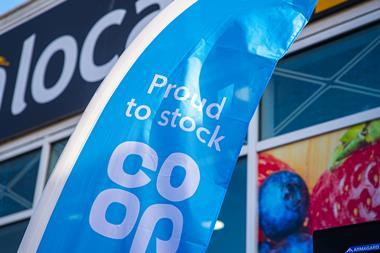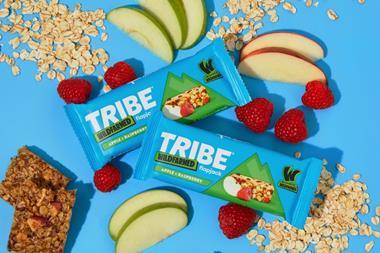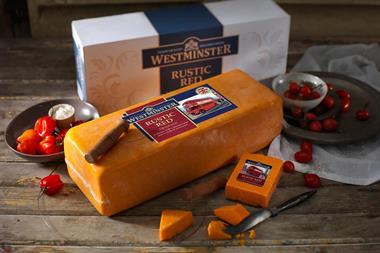Digital media campaigns may be in their infancy but are an increasingly important part of the marketing mix. To date, the grocery industry has done little more than dip its toe in the water. Buf if you think it's time for your company to take the plunge, The Grocer is offering a chance to win six months' free consultancy. It's time to get connected, says Liz Hamson
The race to get Rage Against the Machine to number one at Christmas at the expense of whiny The X-Factor winner Joe McElderry was a ringing endorsement of the power of digital media but you can see why there are so many digital doubters. Just look at the role an innocent-looking Twitter account played in the recent Eurostar fiasco.
Briefed to simply market Little Break, Big Difference holidays, it wasn't primed to respond to people tweeting for emergency travel advice and when five trains broke down in the tunnel, passengers were understandably furious that their tweets went ignored. It's not the sort of impact you want your digital marketing strategy to have. And Eurostar isn't the only one to have had difficulties 'doing' digital.
Built off the back of big-bang, one-way interruption ad campaigns, many leading food and drink brands are finding social media, where attention has to be earned, reciprocated and sustained, hard to get their heads around, says Daljit Bhurji, MD of social media agency Diffusion.
There has been a "huge strategic failure" to integrate advertising, PR, PoS and social media, he adds. "Too often, digital is seen as a bolt-on to amplify a TV campaign rather than something that should be considered at the very start of the campaign design process. 'Integrate, integrate, integrate' needs to be the mantra for food and drink marketers in 2010."
But will it be? Or will brands continue to make the same old mistakes?
Over the past couple of years, social media and crowd sourcing have entered the common lexicon as more companies many food and drink manufacturers and retailers among them have turned to digital media to advertise, brand build, drive footfall, develop new products and safeguard corporate reputation.
The upshot has been an increase in online advertising budgets for the second quarter running, according to the latest Bellwether report. And 2010 promises no let-up in activity indeed, Unilever has just announced it is supporting the launch of its new Lynx Twist variant with Keeping Keeley, an online game hosted on Lynx's Facebook page and Xbox Live (see page 26).
It's no surprise that more fmcg companies are dabbling with digital, say Rob Hollands and Rick Evans, MD and creative director of digital agency Untitled. Successful campaigns allow them to engage with consumers and turn them into brand advocates, says Hollands. "It's the open-source or crowd-source philosophy. They want the community to develop the brand or product with them. These online communities are helping to build, test and evolve the product."
A raft of recent campaigns have been launched with exactly these objectives in mind. Take the recent The Oxo Factor campaign, which encouraged consumers to film their own version of the new Oxo ad, the best of which was shown on TV during The X-Factor final. Or KitKat's Perfect Break, a long-running campaign inviting people to play games online and download music. Or Walkers' Do Us A Flavour, which used digital as part of multi-channel activity to encourage consumers to come up with a new crisp flavour.
All succeeded to a greater or lesser degree in engaging with the consumer. But too many brands are interacting in a fun but ultimately frivolous way, warn the experts. They could be missing a trick, suggests Ged Carroll, director of digital strategies at Ruder Finn. He singles out Cadbury's online eyebrows campaign, which saw the Fallon creative posted online (receiving four million hits) and consumers then invited to create their own versions, which were streamed directly to the MSN homepage JiveBrow09.
"The mistake that even some of the successful campaigns make is that they treat online as just another straight media channel," says Carroll. "The Cadbury campaign didn't allow consumers to interact much with the brand. It treated YouTube as a TV slot."
A lot of recent campaigns have done little more than transpose a TV ad online, agrees Melanie Welsh, head of strategy at Soup. "Too often, the agency involved has crated a high-impact fast-burn campaign that imposes the mentality of broadcast on digital," she says. "These campaigns may garner a great deal of publicity but they are not substantial enough to sustain a meaningful relationship with the customer and benefit the brand too."
The problem is simply that many media agencies have cut their creative teeth with TV and struggle to make the transition to digital, believes Soup MD Nick Thompson. Brands and their media agencies need to literally think outside the box, he says. "TV is a broadcast medium. Digital is far more interactive. The key is to get the different agencies together working on an integrated idea. Digital should be at the heart of the campaign. It's like the glue that holds it together."
Some are already getting it right. "From a digital point of view, the execution could have been better, but Do Us A Flavour tied together beautifully with other media and that's why it worked so well," says one expert. Relentless also hits the mark, says Carroll. "It seems to have out-Red Bulled Red Bull. Its strategy is multi-platform and completely integrated."
But many other brands behave like kids in a sweet shop when they enter the digital arena, grabbing at anything rather than thinking about what they really want to achieve. "The adaptability of social media is perhaps its great strength and weakness," says Bhurji. "Like a Swiss Army knife, many brands struggle to match the right tool to the problem."
He notes the rush to create online communities. "Just because you bring thousands of people together who happen to like a particular soft drink or bar of chocolate, that doesn't mean you will automatically create a vibrant and self-sustaining community of online advocates. Sometimes you get the impression no-one has asked the question: what are we going to do with all these customers once we've brought them together?"
Conversely, why devise a campaign that only speaks to existing customers? Unlike the 'love it hate it' response the product it endorses famously provokes, the recent Marmarati campaign to rope consumers in to help with the development of a new, stronger variant of Marmite elicits a lukewarm response from the experts.
Developed by We Are Social, it deliberately engaged with only the brand's most passionate fans, who via social media were invited to join the Marmarati and help with the product development, packaging design and the launch campaign. Carroll questions the limited scope of the campaign. "Some of the stuff Marmite has done has been quite clever," he says. "But with this they are talking to the converted. It's more of a relationship marketing effort than an attempt to shift units."
At least Unilever is attempting to engage with the consumer directly and not via a third party though. Nestlé sparked controversy earlier this month when 'in-stream advertising' agency Ad.ly revealed the manufacturer was paying celebrities $10,000 to push its products on Twitter. Boycott Nestlé campaigners were quick to attack the company for its 'cynical' promotional tactics.
Even those who do try and communicate directly can come a cropper if they don't understand the interactive nature of digital media. Bhurji cites the example of Skittles, which early last year replaced its homepage with a portal linking to live content from Twitter, Facebook and YouTube.
"It was a prime example of a brand thinking of digital as being all about technology rather than behaviour," he says. "It was an interesting experiment for Agency.com, which built the site, but there was little or no thought given to how the online community would engage with the site or how Skittles would communicate back."
So little, indeed, that within hours of the site going live, the Twitter feed that automatically displayed messages mentioning Skittles had been hijacked by detractors using obscene language. Skittles, a brand that makes sweets primarily for kids, was subsequently forced to age-restrict access to its official website.
It paid the price for failing to take ownership of its digital media strategy, believes Bhurji. "A lack of clear ownership remains one of the key barriers to its further adoption," he says. "There needs to be someone who is willing to take on that role of co-ordinating, developing and then implementing a social media strategy within the brand. Social media requires strong internal advocacy and this can be a particular issue within the highly stratified hierarchical conglomerates responsible for most food and drink brands."
Companies that do digital well tend to invest in it internally, agrees Thompson. "It doesn't mean lots and lots of money but personnel who can keep the content going within the organisation and interact with the consumer via regular communication that doesn't seem invasive."
Without this advocacy, it is very difficult to devise a truly integrated strategy. And integration is key, agree experts. "Brands can't just build a website and expect visitors to come", says Hollands. "They need to reach consumers directly and on their terms through social networks, mobile apps, websites or other tools and tactics. One-way communication has become a two-way dialogue."
Which is where Eurostar got caught out, much to the chagrin of We are Social, which set up the Twitter account. The problems could have been avoided, it blogged ruefully at the time: "We talked to them about the need to put a real-time social media listening and responding programme and crisis plan in place, but they decided to start small to learn from the experience of engaging in conversations in social media."
Eurostar learnt the hard way that it's impossible to simply dip your toe into digital. For those who are brave enough to dive in, however, digital presents a massive opportunity if it is deployed in a truly digital (as opposed to TV-lite) way and is integrated with the wider marketing strategy.
Most brands are only beginning to wake up to digital's full potential, but this year could be the tipping point even if the economy does remain shaky, says Carroll.
"People may struggle to justify the budget," he says. "But if we come out of recession, they might start thinking about growth. If not and they have to cut costs, they could use it in a defensive way to minimise market loss. They might not have any choice but go digital."
If that's the case, they'll need to gen up on the rules of engagement. The good news is that companies are starting to do just that. Last week, Coca-Cola published a guide to engaging with social media for its 92,400 employees worldwide. It has recognised that its brand reputation is no longer just in the hands of a handful of marketing executives and PR representatives.
Isn't it time everyone else did too?
Find out how to enter and win six months' free consultancy.
Sign in to comment on this article
Not logged in before? Register for FREE guest access today.
You will be able to:
- Read more stories
- Receive daily newsletters
- Comment on stories
Advert



![XOXO-Product-Shot[ALL FLAVOUR]-Sky-1920x1080](https://dmrqkbkq8el9i.cloudfront.net/Pictures/274x183/4/9/2/355492_xoxoproductshotallflavoursky1920x1080_806584_crop.jpg)




![XOXO-Product-Shot[ALL FLAVOUR]-Sky-1920x1080](https://dmrqkbkq8el9i.cloudfront.net/Pictures/380x253/4/9/2/355492_xoxoproductshotallflavoursky1920x1080_806584_crop.jpg)




No comments yet